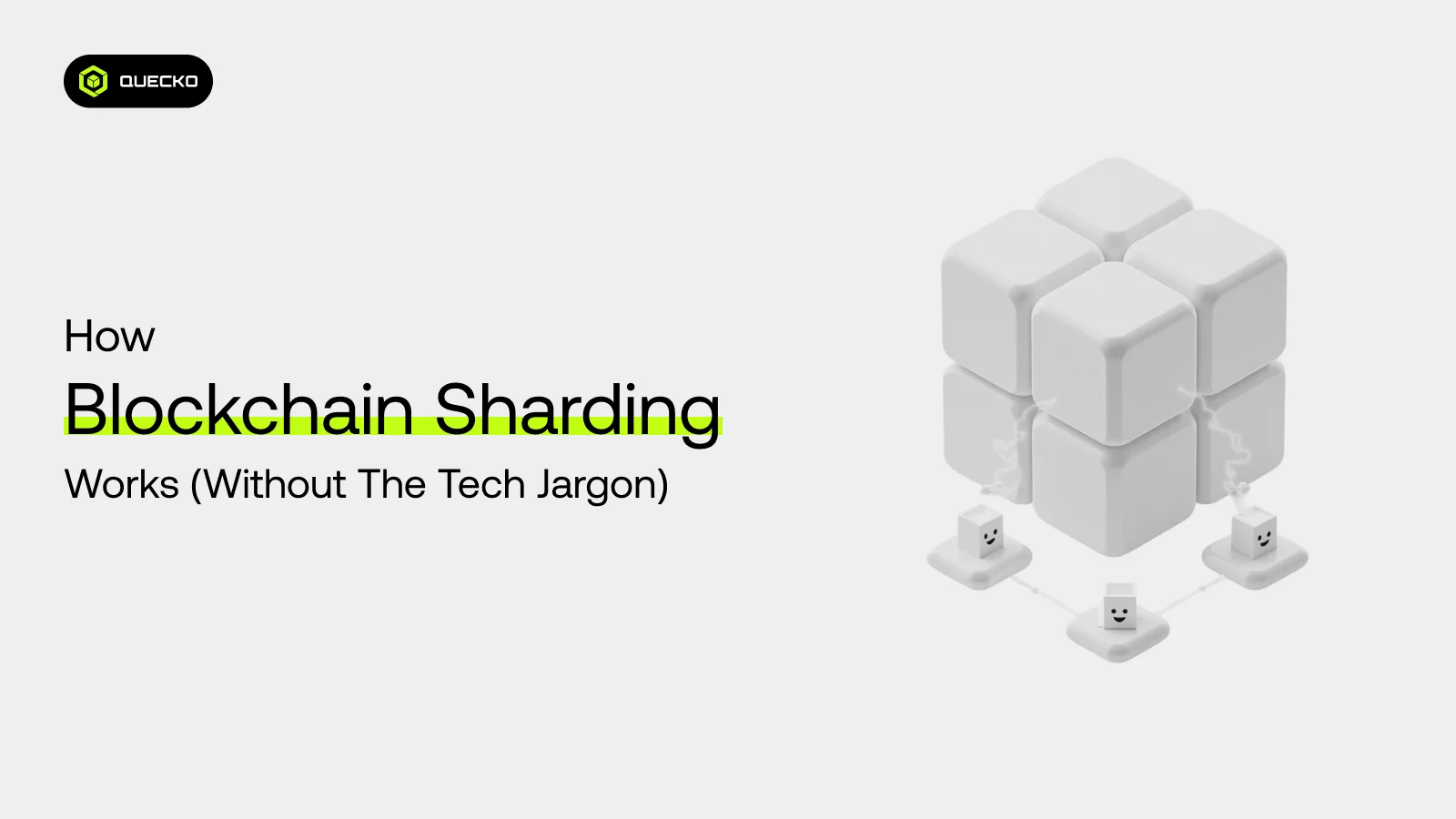How to Scale Layer 2 in Blockchain: A Comprehensive Guide
Explore our guide on scaling Layer 2 in blockchain, featuring cutting-edge technologies, strategies, and best practices for enhanced scalability and performance.
Blockchain technology has taken the world by storm, revolutionizing decentralization, security, and trust. Yet, as these networks expand, they grapple with significant scalability challenges that threaten their efficiency and user experience. Enter Layer 2 solutions—an innovative approach that promises to supercharge blockchain performance. In this blog, we’ll dive deep into the world of Layer 2 scaling, uncover its importance, and explore the various strategies that are set to redefine the future of decentralized systems. By the end of this journey, you’ll grasp how Layer 2 solutions can propel blockchain technology to new heights and why they are indispensable for the evolution of this groundbreaking space.
What is Layer 2 Scaling?
Layer 2 scaling refers to solutions built on top of existing blockchains (Layer 1) to enhance transaction speed, reduce costs, and increase overall network efficiency. These solutions operate independently from the base blockchain but leverage its security features. Unlike Layer 1 scaling, which involves modifying the core protocol of the blockchain (such as increasing block size or altering consensus mechanisms), Layer 2 solutions aim to offload transactions and computations from the main chain, thereby reducing the load on the base layer and improving performance.
Layer 1 vs. Layer 2
Understanding the differences between Layer 1 and Layer 2 solutions is crucial for grasping their respective roles in blockchain scalability:
Layer 1 Solutions
Layer 1 solutions focus on making changes to the underlying blockchain protocol itself. This can include:
- Increasing Block Size: Allowing more transactions to be included in each block, thereby increasing throughput. However, this approach can lead to centralization concerns as larger block sizes require more storage and bandwidth.
- Changing Consensus Mechanisms: Adopting more efficient consensus algorithms (e.g., transitioning from Proof of Work to Proof of Stake) to improve transaction processing times and energy efficiency.
- Implementing Sharding: Dividing the blockchain into smaller, manageable pieces (shards) that can process transactions in parallel, thereby increasing overall throughput.
While Layer 1 improvements are foundational and can lead to significant gains in scalability, they often require consensus among the entire network, making them challenging to implement.
Layer 2 Solutions
Layer 2 solutions operate on top of the existing blockchain and aim to handle transactions off-chain, alleviating the burden on the main chain. This approach allows for faster and cheaper transactions without compromising the security provided by the base layer. Key characteristics of Layer 2 solutions include:
- Off-Chain Transactions: Moving transactions off the main chain and onto secondary layers or channels. This reduces the number of transactions that need to be processed and recorded on the base layer.
- Security Reliance on Layer 1: Layer 2 solutions leverage the security and decentralization of the main chain, ensuring that off-chain transactions remain secure and trustless.
Benefits of Layer 2 Scaling
Layer 2 scaling offers several advantages that make it an attractive solution for enhancing blockchain performance:
Increased Transaction Speed
Layer 2 solutions enable faster transaction processing by handling transactions off-chain. This off-chain processing reduces the time required for transactions to be confirmed and recorded on the blockchain, leading to quicker transaction finality.
Lower Costs
By reducing on-chain activity, Layer 2 solutions significantly lower transaction fees. Since fewer transactions need to be processed by the base layer, the cost associated with transaction validation and inclusion is reduced. This makes blockchain transactions more affordable for users and opens up new use cases that were previously cost-prohibitive.
Reduced Congestion
Moving transactions off-chain helps alleviate network congestion on the main chain. This reduction in congestion ensures that the base layer can handle more transactions without experiencing delays or bottlenecks. As a result, the overall user experience is improved, and the blockchain can support a higher volume of transactions.
Types of Layer 2 Solutions
Layer 2 solutions are crucial for addressing the scalability challenges faced by blockchain networks. By offloading transactions and computations from the main chain, these solutions enhance transaction speed, reduce costs, and increase overall network efficiency. Here, we’ll explore the different types of Layer 2 solutions in detail:
1. State Channels
State Channels allow participants to conduct multiple transactions off-chain, with only the initial and final states being recorded on the main chain. This approach is ideal for scenarios requiring frequent interactions, such as micropayments, gaming, and peer-to-peer exchanges. State channels operate as follows:
- Opening a Channel: Participants create a state channel by locking a certain amount of assets in a smart contract on the main chain.
- Off-Chain Transactions: Participants can then conduct an unlimited number of transactions off-chain. These transactions are instantaneous and incur minimal fees since they do not require blockchain confirmation.
- Closing the Channel: When the participants decide to close the channel, the final state of the transactions is recorded on the main chain. The smart contract ensures that the final balances are correctly updated.
The primary advantage of state channels is that they enable fast and low-cost transactions, making them ideal for real-time applications. However, they require both parties to be online during the transaction process.
2. Sidechains
Sidechains are independent blockchains connected to the main chain through a two-way peg, allowing assets to move between the main chain and the sidechain. Sidechains operate in parallel with the main chain and have their own consensus mechanisms and security protocols. Key features of sidechains include:
- Two-Way Peg: A mechanism that ensures assets can be securely transferred between the main chain and the sidechain. When assets move to the sidechain, they are locked on the main chain and unlocked on the sidechain.
- Independent Operation: Sidechains can operate independently, enabling developers to experiment with new features and consensus mechanisms without affecting the main chain.
- Customization: Sidechains can be tailored to specific use cases, such as faster transaction processing or privacy enhancements.
While sidechains offer flexibility and faster transactions, they rely on their own security mechanisms, which may not be as robust as the main chain’s security.
3. Rollups
Rollups bundle multiple transactions into a single batch and submit them to the main chain, significantly reducing the load on the main chain. There are two main types of rollups: Optimistic Rollups and ZK-Rollups.
- Optimistic Rollups:
- Assume transactions are valid by default and only require verification if there is a dispute.
- Off-chain transactions are bundled and periodically submitted to the main chain.
- Validators monitor the rollups and can challenge fraudulent transactions, which are then checked and corrected if necessary.
- Advantages: Reduced computational load on the main chain, faster transaction processing, and lower fees.
- Example: Optimism and Arbitrum.
- ZK-Rollups (Zero-Knowledge Rollups):
- Use zero-knowledge proofs to validate transactions off-chain instantly.
- ZK-Rollups generate cryptographic proofs that confirm the validity of all transactions within a batch without revealing individual transaction details.
- These proofs are submitted to the main chain, which only needs to verify the proof rather than each transaction.
- Advantages: Enhanced security, instant finality, and reduced data transmission.
- Example: zkSync and Loopring.
Rollups offer significant scalability improvements by reducing the amount of data that needs to be processed and stored on the main chain.
4. Plasma
Plasma chains are secondary blockchains that rely on the main chain for security. Plasma uses a hierarchical structure to process transactions off-chain, periodically committing the state to the main chain. Key aspects of Plasma include:
- Hierarchical Tree Structure: Plasma chains are organized in a tree-like structure, with multiple child chains branching off from the main chain.
- Periodic Checkpoints: Plasma chains submit periodic checkpoints or proofs to the main chain to ensure the integrity and security of off-chain transactions.
- Fraud Proofs: Participants can challenge invalid transactions using fraud proofs, which are resolved on the main chain.
Plasma is suitable for scalable applications, as it can handle a large number of transactions off-chain while maintaining security through periodic main chain commitments.
5. Validium
Validium combines the benefits of ZK-Rollups with off-chain data availability, ensuring scalability while maintaining security and privacy. Validium operates as follows:
- Off-Chain Data Storage: Transaction data is stored off-chain, reducing the storage burden on the main chain.
- Zero-Knowledge Proofs: Similar to ZK-Rollups, Validium uses zero-knowledge proofs to validate transactions without revealing individual details.
- Enhanced Scalability: By keeping data off-chain and using cryptographic proofs, Validium achieves high throughput and low latency.
Validium offers an optimal solution for applications that require high scalability and privacy, such as enterprise blockchain solutions and confidential transactions.
Types of Layer 2 Solutions
Layer 2 solutions are crucial for addressing the scalability challenges faced by blockchain networks. By offloading transactions and computations from the main chain, these solutions enhance transaction speed, reduce costs, and increase overall network efficiency. Here, we’ll explore the different types of Layer 2 solutions in detail:
1. State Channels
State Channels allow participants to conduct multiple transactions off-chain, with only the initial and final states being recorded on the main chain. This approach significantly improves transaction throughput, making it ideal for scenarios requiring frequent interactions, such as micropayments, gaming, and peer-to-peer exchanges. Since only a few transactions touch the main chain, transaction costs are reduced, enhancing efficiency.
Additionally, optimistic rollups complement state channels by further optimizing off-chain computation while ensuring security through fraud proofs. This synergy benefits various decentralized applications (DApps), allowing them to process high volumes of transactions without burdening the main blockchain.
This setup enables scalability while maintaining decentralization—a powerful combination for blockchain innovation.
- Opening a Channel: Participants create a state channel by locking a certain amount of assets in a smart contract on the main chain.
- Off-Chain Transactions: Participants can then conduct an unlimited number of transactions off-chain. These transactions are instantaneous and incur minimal fees since they do not require blockchain confirmation.
- Closing the Channel: When the participants decide to close the channel, the final state of the transactions is recorded on the main chain. The smart contract ensures that the final balances are correctly updated.
The primary advantage of state channels is that they enable fast and low-cost transactions, making them ideal for real-time applications. However, they require both parties to be online during the transaction process.
2. Sidechains
Sidechains are independent blockchains connected to the main chain through a two-way peg, allowing assets to move between the main chain and the sidechain. Sidechains operate in parallel with the main chain and have their own consensus mechanisms and security protocols. Key features of sidechains include:
- Two-Way Peg: A mechanism that ensures assets can be securely transferred between the main chain and the sidechain. When assets move to the sidechain, they are locked on the main chain and unlocked on the sidechain.
- Independent Operation: Sidechains can operate independently, enabling developers to experiment with new features and consensus mechanisms without affecting the main chain.
- Customization: Sidechains can be tailored to specific use cases, such as faster transaction processing or privacy enhancements.
While sidechains offer flexibility and faster transactions, they rely on their own security mechanisms, which may not be as robust as the main chain’s security.
3. Rollups
Rollups bundle multiple transactions into a single batch and submit them to the main chain, significantly reducing the load on the main chain. There are two main types of rollups: Optimistic Rollups and ZK-Rollups.
- Optimistic Rollups:
- Assume transactions are valid by default and only require verification if there is a dispute.
- Off-chain transactions are bundled and periodically submitted to the main chain.
- Validators monitor the rollups and can challenge fraudulent transactions, which are then checked and corrected if necessary.
- Advantages: Reduced computational load on the main chain, faster transaction processing, and lower fees.
- Example: Optimism and Arbitrum.
- ZK-Rollups (Zero-Knowledge Rollups):
- Use zero-knowledge proofs to validate transactions off-chain instantly.
- ZK-Rollups generate cryptographic proofs that confirm the validity of all transactions within a batch without revealing individual transaction details.
- These proofs are submitted to the main chain, which only needs to verify the proof rather than each transaction.
- Advantages: Enhanced security, instant finality, and reduced data transmission.
- Example: zkSync and Loopring.
Rollups offer significant scalability improvements by reducing the amount of data that needs to be processed and stored on the main chain.
4. Plasma
Plasma chains are secondary blockchains that rely on the main chain for security. Plasma uses a hierarchical structure to process transactions off-chain, periodically committing the state to the main chain. Key aspects of Plasma include:
- Hierarchical Tree Structure: Plasma chains are organized in a tree-like structure, with multiple child chains branching off from the main chain.
- Periodic Checkpoints: Plasma chains submit periodic checkpoints or proofs to the main chain to ensure the integrity and security of off-chain transactions.
- Fraud Proofs: Participants can challenge invalid transactions using fraud proofs, which are resolved on the main chain.
Plasma is suitable for scalable applications, as it can handle a large number of transactions off-chain while maintaining security through periodic main chain commitments.
5. Validium
Validium combines the benefits of ZK-Rollups with off-chain data availability, ensuring scalability while maintaining security and privacy. Validium operates as follows:
- Off-Chain Data Storage: Transaction data is stored off-chain, reducing the storage burden on the main chain.
- Zero-Knowledge Proofs: Similar to ZK-Rollups, Validium uses zero-knowledge proofs to validate transactions without revealing individual details.
- Enhanced Scalability: By keeping data off-chain and using cryptographic proofs, Validium achieves high throughput and low latency.
Validium offers an optimal solution for applications that require high scalability and privacy, such as enterprise blockchain solutions and confidential transactions.
Key Technologies Behind Layer 2 Scaling
Layer 2 scaling solutions rely on several key technologies to enhance blockchain performance and efficiency. These technologies enable off-chain processing, ensure transaction validity, and maintain security. Let’s explore these key technologies in detail:
Smart Contracts
Smart contracts are self-executing contracts with the terms of the agreement directly written into code. They play a crucial role in Layer 2 scaling solutions by automating off-chain transactions and ensuring trustless execution. Here’s how smart contracts contribute to Layer 2 scaling:
- Automation: Smart contracts automatically execute predefined actions when certain conditions are met, eliminating the need for intermediaries. This automation reduces the complexity and cost of transactions.
- Trustless Execution: Smart contracts operate on the principle of trustless execution, meaning that the contract will execute as programmed without the need for trust between parties. This ensures that off-chain transactions are secure and reliable.
- Interoperability: Smart contracts facilitate seamless interaction between the Layer 2 solution and the main chain. They can lock assets on the main chain, enable off-chain transactions, and ensure the correct final state is recorded on the main chain.
Smart contracts are the backbone of many Layer 2 solutions, such as state channels and rollups, enabling efficient and secure off-chain processing.
Cryptographic Proofs
Cryptographic proofs are mathematical techniques used to validate transactions and ensure data integrity without revealing sensitive information. Zero-knowledge proofs (ZKPs) are a prominent type of cryptographic proof used in Layer 2 scaling solutions. Here’s how cryptographic proofs contribute to Layer 2 scaling:
- Zero-Knowledge Proofs (ZKPs): ZKPs allow one party to prove to another that a statement is true without revealing any underlying information. In the context of Layer 2, ZKPs can validate transactions off-chain and generate a proof that can be verified on-chain. This ensures transaction validity while maintaining privacy.
- Fraud Proofs: Fraud proofs are used in solutions like Optimistic Rollups. They assume that transactions are valid by default and only require verification if a dispute arises. If a fraudulent transaction is detected, a fraud-proof is submitted to the main chain for resolution.
- Data Integrity: Cryptographic proofs ensure that the data committed to the main chain accurately represents the off-chain transactions. This guarantees that off-chain computations are secure and verifiable.
Cryptographic proofs enable Layer 2 solutions to maintain high levels of security and privacy while reducing the data and computational load on the main chain.
Consensus Mechanisms
Consensus mechanisms are protocols used to achieve agreement among network participants on the validity of transactions. While Layer 2 solutions leverage the consensus mechanisms of the main chain for security, they also employ their own mechanisms to validate off-chain transactions. Here’s how consensus mechanisms contribute to Layer 2 scaling:
- Off-Chain Validation: Layer 2 solutions implement lightweight consensus mechanisms to validate transactions off-chain, enabling numerous transactions to be processed efficiently without overloading the main chain.
- Security: By leveraging the security of the main chain’s consensus mechanism, Layer 2 solutions ensure trustlessness and decentralization. Periodic commitments anchor off-chain transactions on the main chain, making them tamper-proof.
- Scalability & Transaction Capacity: Efficient consensus mechanisms help process thousands of transactions quickly, improving transaction capacity while maintaining security.
- Virtual Machine Execution: Many Layer 2 solutions integrate with a virtual machine, enabling smart contract execution and transaction processing within the blockchain space without compromising efficiency.
- Faster Transaction Times & Cost Reduction: Optimized consensus protocols improve faster transaction times by reducing bottlenecks and minimizing delays, making interactions seamless.
- Private Blockchains & Custom Consensus Models: Some Layer 2 implementations cater to private blockchains, adapting their consensus mechanisms to fit specific governance models and enterprise-grade solutions.
Consensus mechanisms, whether on-chain or off-chain, are vital for the security, efficiency, and scalability of Layer 2 solutions.
Challenges in Scaling Layer 2
While Layer 2 scaling solutions enhance transaction throughput, reduce transaction costs, and improve network efficiency, they also present certain challenges that developers and stakeholders must address for successful implementation. Some key challenges include:
- Optimistic Rollups & Security Risks: While optimistic rollups help scale transactions efficiently, they rely on fraud proofs, which can introduce delays in dispute resolution and security concerns.
- Transaction Costs & Liquidity Management: Although Layer 2 solutions generally reduce transaction costs, users may still face fees when settling transactions back to the main chain, affecting liquidity.
- Decentralized Applications (DApps) Compatibility: Integrating Layer 2 with existing decentralized applications requires careful consideration, as some DApps may need modifications to work seamlessly.
- Blockchain Trilemma: Achieving decentralization, scalability, and security—the blockchain trilemma—remains a fundamental challenge for Layer 2 networks, often requiring trade-offs in one area.
- Consensus Protocol Efficiency: The design and execution of consensus protocols for Layer 2 solutions must ensure speed and security while maintaining trust among participants.
- Payment Channels & User Adoption: Payment channels, which enable fast transactions, must be user-friendly and widely adopted to realize their full potential in facilitating real-world payments.
- Scalable Solution Sustainability: While Layer 2 networks offer a scalable solution, long-term sustainability depends on continued innovation, developer support, and market acceptance.
Security Risks
Layer 2 solutions, while enhancing scalability, may introduce new security vulnerabilities. Some of the notable security risks include:
- Fraud in Optimistic Rollups: Optimistic Rollups assume that transactions are valid by default and rely on validators to challenge fraudulent transactions. This challenge mechanism requires a window of time during which disputes can be raised. If the challenge period is insufficient or if validators act maliciously, fraudulent transactions may go undetected.
- Data Availability Issues in Validium: Validium combines ZK-Rollups with off-chain data availability, meaning that transaction data is stored off-chain. Ensuring that this data remains available for verification is critical. If the data becomes unavailable or is withheld by malicious actors, it can compromise the integrity and security of the off-chain transactions.
- Smart Contract Vulnerabilities: Smart contracts underpin many Layer 2 solutions, and any vulnerabilities in the contract code can be exploited by attackers. Ensuring the security of smart contracts through rigorous auditing and testing is essential to prevent potential exploits.
Future Trends in Layer 2 Scaling
Layer 2 scaling solutions are constantly evolving, and several emerging trends are set to shape the future of blockchain technology. These trends focus on enhancing scalability, security, and interoperability, ultimately driving the widespread adoption of decentralized systems. Let’s explore these future trends in detail:
Best Practices for Implementing Layer 2 Solutions
Layer 2 solutions are pivotal in addressing the scalability limitations of blockchain networks. By offloading transactions from the main chain (Layer 1) to secondary protocols, Layer 2 solutions enable faster, cheaper, and more efficient transactions. However, implementing these solutions requires careful planning and adherence to best practices to ensure security, scalability, and user adoption. Below are detailed best practices for implementing Layer 2 solutions:
1. Security Audits
Security is paramount in blockchain systems, and Layer 2 solutions are no exception. Since Layer 2 protocols interact with the main chain and handle significant value, vulnerabilities can lead to catastrophic losses.
Key Considerations:
- Regular Audits: Conduct frequent security audits by reputable third-party firms to identify and mitigate vulnerabilities. Audits should cover smart contracts, cryptographic implementations, and protocol logic.
- Bug Bounty Programs: Encourage ethical hackers to identify vulnerabilities by offering rewards for discovering bugs.
- Formal Verification: Use formal verification methods to mathematically prove the correctness of smart contracts and protocols.
- Upgradability with Caution: Ensure that any upgrade mechanisms are secure and do not introduce new vulnerabilities. Use timelocks or multi-signature schemes for critical upgrades.
- Monitoring and Incident Response: Implement real-time monitoring tools to detect anomalies and have a robust incident response plan in place.
2. User Education
Layer 2 solutions, such as Lightning Networks, play a vital role in enhancing scalability and improving transaction throughput for major blockchains like Bitcoin and Ethereum. These solutions allow for processing transactions off-chain, reducing congestion on the main chain while ensuring faster and more cost-effective interactions.
Educating users about Layer 2 blockchain technologies is essential to drive adoption and ensure seamless integration. Understanding how these networks operate and how they optimize processing transactions helps users take full advantage of the benefits they offer—whether it’s speeding up payments, reducing fees, or enabling decentralized applications.
Key Considerations:
- Documentation: Provide comprehensive and easy-to-understand documentation, including tutorials, FAQs, and troubleshooting guides.
- Onboarding Tools: Develop user-friendly interfaces, such as wallets or dashboards, that abstract away the complexity of Layer 2 interactions.
- Educational Content: Create blogs, videos, and webinars to explain the benefits and workings of Layer 2 solutions.
- Feedback Channels: Establish channels for users to ask questions and provide feedback, fostering a sense of community and trust.
- Gamification: Use gamified learning experiences to engage users and help them understand Layer 2 concepts.
3. Scalability Testing
Layer 2 solutions are designed to handle high transaction volumes, but thorough testing is essential to ensure they can scale effectively under real-world conditions.
Key Considerations:
- Load Testing: Simulate high transaction volumes to test the system’s performance and identify bottlenecks.
- Stress Testing: Push the system to its limits to understand how it behaves under extreme conditions.
- Network Conditions: Test under various network conditions, including latency and packet loss, to ensure robustness.
- Interoperability Testing: Ensure compatibility with different Layer 1 blockchain and other Layer 2 solutions.
- Real-World Scenarios: Test with real-world use cases, such as decentralized finance (DeFi) applications or non-fungible token (NFT) marketplaces, to validate performance.
4. Community Engagement
The success of Layer 2 solutions often depends on the support and involvement of the community. Engaging the community fosters innovation, builds trust, and ensures the solution meets user needs.
Key Considerations:
- Open-Source Development: Make the codebase open-source to encourage transparency and collaboration.
- Governance Models: Implement decentralized governance models that allow the community to participate in decision-making.
- Hackathons and Grants: Organize hackathons and provide grants to incentivize developers to build on the Layer 2 solution.
- Feedback Loops: Actively seek feedback from the community and incorporate it into the development process.
- Community Ambassadors: Appoint community ambassadors to educate and onboard new users and developers.
Conclusion
Layer 2 scaling solutions are revolutionizing blockchain technology by addressing the scalability challenges of Layer 1 networks. From state channels to rollups, these solutions enable faster, cheaper, and more efficient transactions, paving the way for the mass adoption of decentralized systems.
However, implementing Layer 2 solutions requires a holistic approach that prioritizes security, user education, scalability, and community engagement. By adhering to best practices such as regular security audits, thorough scalability testing, and fostering a vibrant community, developers can ensure the success and sustainability of Layer 2 solutions.
As the blockchain ecosystem continues to evolve, Layer 2 scaling will play a crucial role in shaping the future of decentralized applications and systems. By embracing these best practices, stakeholders can unlock the full potential of Layer 2 solutions and drive the next wave of innovation in blockchain technology.
Date
5 months agoShare on
Related Blogs

What Happens When LLMs Trade On-Chain? Autonomous Agents in Crypto
2 days ago

Behind the Gas Fees: What Happens During a Congested Block?
10 days ago

Stablecoins Uncovered: How They Keep Their Value Stable
10 days ago

How ‘Blockchain Sharding’ Works (Without the Tech Jargon)
16 days ago








